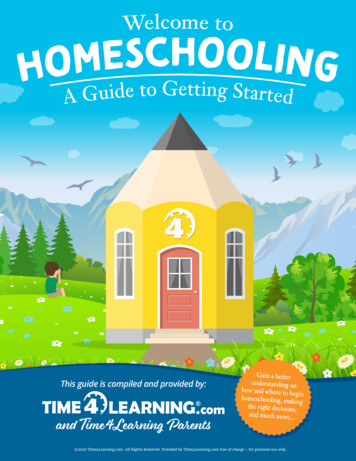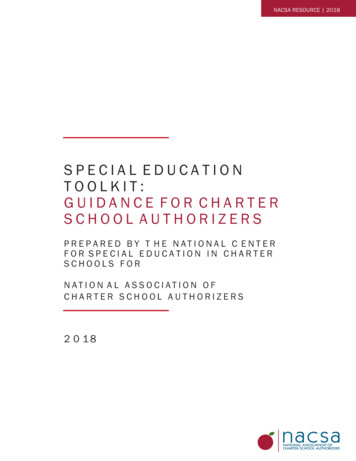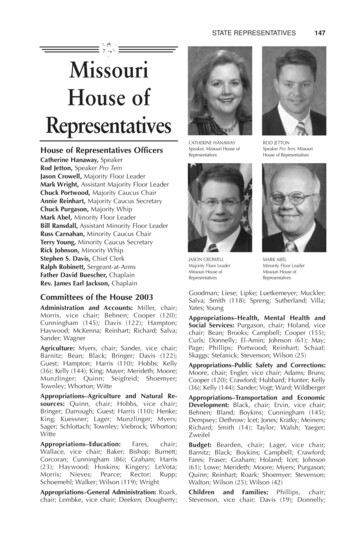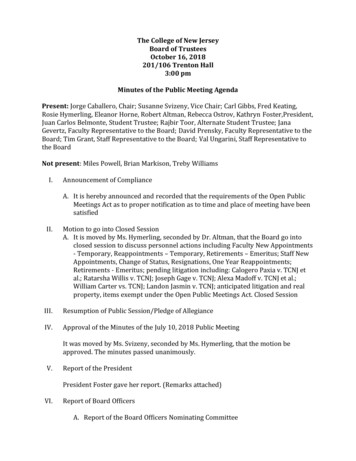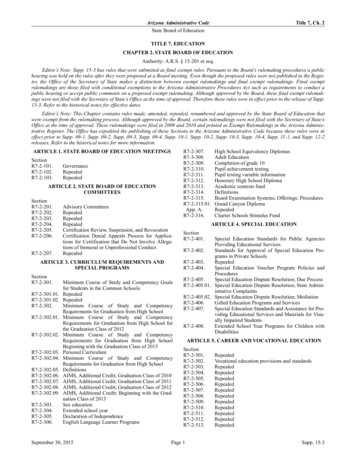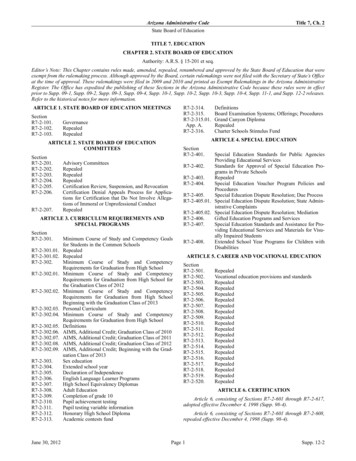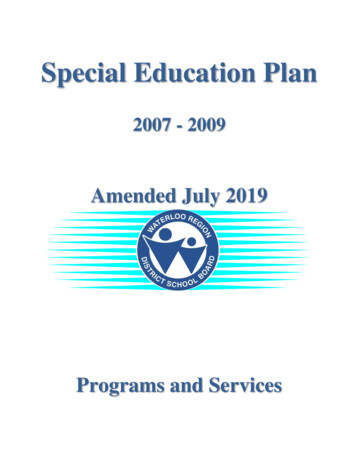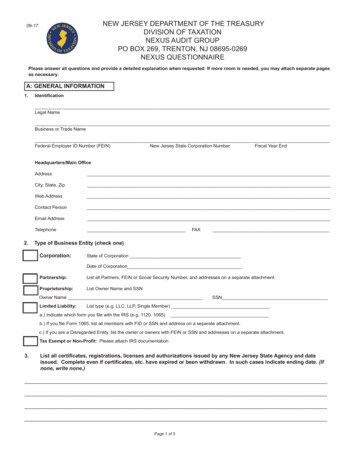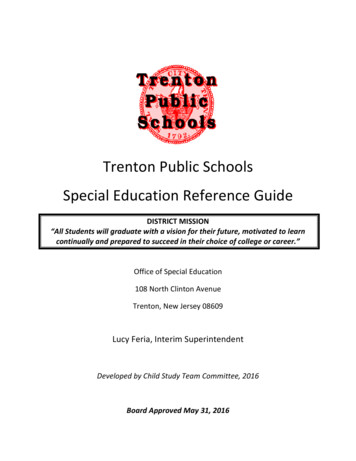
Transcription
Trenton Public SchoolsSpecial Education Reference GuideDISTRICT MISSION“All Students will graduate with a vision for their future, motivated to learncontinually and prepared to succeed in their choice of college or career.”Office of Special Education108 North Clinton AvenueTrenton, New Jersey 08609Lucy Feria, Interim SuperintendentDeveloped by Child Study Team Committee, 2016Board Approved May 31, 2016
Board MembersJason Redd, PresidentGerald Truehart, Vice PresidentDr. Jane RosenbaumFiah GussinGuillermo Gomez-SalazarDr. D. A. GrahamLucy VandenburgAniya Guzman (Student)Leadership TeamMs. Lucy Feria, Interim SuperintendentDr. Josue Falaise, Interim Chief Academic OfficerJayne S. Howard, Business AdministrationBusiness OfficeWilfredo Ortiz, Interim Assistant SuperintendentOffice of School SupportElizabeth DeJesus, Assistant SuperintendentOffice of Special Education and Student ServicesLissa Johnson, Assistant SuperintendentOffice Talent Acquisition and DevelopmentPerry L. Lattiboudere, Esq., General CounselThe District is an Equal Opportunity Employer. Employees are guaranteed equal access to all categories of employment as well as retention andadvancement regardless of race, creed, color, national origin, nationality, ancestry, age, sex (including pregnancy), familial status, maritalstatus, domestic partnerships status, affectional or sexual orientation, atypical hereditary cellular or blood trait, genetic information, liability formilitary service, mental or physical disability, perceived disability, AIDS and HIV status, political activities, domicile, or membership orparticipation in or association with activities of any employee organization.Any employee who believes he/she has been subject to discrimination within employment opportunities on the basis of race, creed, color,national origin, ancestry, age, marital status, affectional or sexual orientation, gender, religion, disability, or socioeconomic status may submit awritten complaint to his/her immediate supervisor or administrator. 2
TABLE OF CONTENTSTOPICPAGE NUMBERI. Introduction3II. Initial Intervention5III. Referral to the Child Study Team7IV. Evaluation11V. Eligibility13VI. The Individualized Education Plan (IEP)17VII. Additional Topics Regarding Students20with IEPsVIII. Frequently Asked Questions (FAQs)27IX. Glossary of Terms/Acronyms31X. References/Acknowledgements39 3
IntroductionPublic schools are required by law to develop a process for identifying potentially educationally disabledstudents. An educationally disabled student is one who may be experiencing difficulties of a physical,emotional, academic, intellectual, or social nature to the extent that the student is not able to functioneffectively in a regular education program. To meet the needs of students, ages 3 through 21 in theTrenton community, as required by New Jersey state law and federal statutes, the Board of Educationprovides programs for students with special needs. Special classes and support programs are locatedthroughout the district. It is the goal of the Trenton Public School District Office of Special Education toencourage the appropriate extent of student participation in the general education program of eachschool.Each building is assigned the services of a Child Study Team (CST) consisting of the school psychologist,learning disabilities teacher consultant (LDT/C), and school social worker. The Child Study Teamevaluates and determines eligibility of students for special education and related services; coordinatesthe development of various aspects of the individualized educational programs; delivers related servicesto educationally disabled students; provides preventive and support services to nondisabled students;and provides services to the general education programs regarding techniques, materials, and programsfor students experiencing learning difficulties.This document is provided as a guide for the provision of special education and related services forstudents in the Trenton Public School District. While this document is meant as a general basis ofinformation, it was not intended, nor should it be construed, as defining the legal basis of specialeducation identification, evaluation, and/or placement. If any portion of this document conflicts withlaw or regulation, the law or regulation takes precedence.The Trenton Public Schools Office of Special Education is responsible for the evaluation of students. TheChild Study Team (CST) is a multi-disciplinary educational team that is responsible to locate, identify,evaluate, determine eligibility, and develop an Individualized Education Program (IEP) for studentssuspected of having educational disabilities. This group of specialists is employed by the Trenton PublicSchool district to provide consultative, evaluative and prescriptive services to teachers and parents. Theteam provides diagnostic services to children from age 3 to 21 that have been identified as having apotential disabling condition. In order to become eligible to receive special education services, a studentmust be evaluated and determined eligible by an IEP team (CST, parent and teacher).Members of the Child Study TeamSchool PsychologistSchool psychologists are uniquely qualified members of school teams that support students' ability tolearn and teachers' ability to teach. They apply expertise in mental health, learning, and behavior, tohelp children and youth succeed academically, socially, behaviorally, and emotionally. Schoolpsychologists partner with families, teachers, school administrators, and other professionals to createsafe, healthy, and supportive learning environments that strengthen connections between home,school, and the community. School psychologists must be credentialed by the state in which they work.They also may be nationally certified by the National School Psychology Certification Board (NSPCB). 4
As a member of the CST, the school psychologist consults with the student’s teachers and assesses thestudent’s current cognitive (thinking and learning), social, adaptive, and emotional status. The activitiesinvolved in the evaluation vary at times from student to student but, in general, most children are givenan intelligence test to determine a child’s likelihood for success within the academic arena. For certainstudents the school psychologist may provide counseling, crisis intervention or consultative services.Learning Disabilities Teacher/Consultant (LDT/C)The Learning Disabilities Teacher-Consultant (LDT/C) is a teacher who functions in the schoolenvironment as an educational diagnostician, instructional programmer, Child Study Team member,educational consultant and instructional leader. LDTCs work in collaboration with other members of achild study team to determine eligibility for special services. LDTCs also consult with parents, teachers,and other school personnel to provide research-based instructional strategies to assist pupils strugglingacademically. An educational assessment is the responsibility of a learning disabilitiesteacher/consultant employed by the district board of education. It shall include review of the student’seducational history, conferences with the student’s teacher(s), and an evaluation and analysis of thestudent’s academic performance and learning characteristics.School Social WorkerThe school social worker, evaluates students’ affective and social skills, counsels students and parents,communicates with community agencies, consults with school staff, and conducts training activities. Asa member of the Child Study Team, the social worker contributes to the CST evaluation process byconducting a “social history evaluation.” The social history evaluation is an assessment of biopsychosocial factors (social, emotional, physical, behavioral and cultural) that may impact a child’sadjustment to and performance in school. The school social worker may also provide counseling, crisisintervention and consultation services, as well as helping families’ access community services.Case ManagerIn addition to their respective roles, the social worker, school psychologist, and learning consultant alsoserve as case managers for students receiving special education services. Students are assigned a casemanager at the time of the referral; however, periodically there are changes in assignments. The casemanager coordinates the evaluation process and IEP development, as well as the monitoring andevaluation of the effectiveness of the IEP. The case manager facilitates communication between homeand school, and coordinates the annual review and reevaluation process. The case manager isknowledgeable about the student’s educational needs and program, as well as special educationprocedures and procedural safeguards, and is responsible for transition planning. A speech/ languagespecialist may also serve as a case manager. 5
Initial InterventionIntervention and Referral Services (I&RS) for general education students is intended as a primary way inwhich general education teachers or specialists can assist a student who is at risk for school problemswithin the general education environment. I&RS programs are not intended to replace traditionalmethods or resources for helping students to function effectively in school. Rather, they exist primarilyto focus on particular student problems using available resources within the general educationenvironment.The primary purposes of the I&RS team are to: Identify students in need and then plan and provide appropriate intervention for those studentswithin the general education community; Identify the responsibilities of building staff who participate in the planning and provision ofintervention and referral services; Actively involve parents/guardians in the development and implementation of the I&RS plans; Review and assess the effectiveness of the services provided in achieving the outcomesidentified in the intervention and referral plan; Provide professional development to general education staff members who either referstudents to the I&RS or who assist in providing the intervention and referral services; and,finally, Coordinate the services of community based social and health agencies.An I&RS team is one of the many resources used by schools to intervene with student problems, prior toChild Study Team (CST) evaluation.INTERVENTION AND REFERRAL SERVICES TEAM PROCESS (I&RS)The Intervention and Referral Services Team process is a collaborative school effort between districtpersonnel and parent(s)/guardian(s) to intervene when a student has been identified as making minimalacademic and/or emotional progress in the general education setting. The team or committee collectsand evaluates relevant data in order to determine or identify specific barriers to student performance.Once these barriers have been identified, individualized interventions are determined and implementedthrough an action plan in order to alleviate the concerns. In some instances this may include the use ofthe Response to Intervention Model. Although several variations of the model have been proposed, ingeneral, RTI is based upon three components: the use of multiple tiers of increasingly intenseinterventions; a problem-solving approach to identify and evaluate instructional strategies; and anintegrated data collection and assessment system to monitor student progress and guide decisions atevery level. Student monitoring continues throughout this process by the identified individuals in theaction plan. This process is ongoing and it continues to identify and evaluate problems, solutions andprogress within the student’s academic setting. 6
I&RS PHASES1. Request for assistance2. Information collection3. Parent(s)/Guardian(s) notification and participation4. Problem solve5. Develop I&RS action plan6. Support, monitor and continue the process7. Problem resolved or referral to CSTIf the I&RS process exhausts all of the available school based general education interventions withminimal success, often the student is then referred to the CST for a comprehensive evaluation in orderto gather additional information as well as to determine if the student is eligible for special educationand related services. The recommendation for a CST evaluation could come directly from the I&RS teamor from the parent(s)/guardian(s) at any time during the process.WHAT INTERVENTION IS AND IS NOTThe term intervention is used when teachers and other school personnel study and creatively problemsolve educational issues that place a student at risk for school failure. Using a team approach that alsosignificantly involves parent(s)/guardian(s), each school carefully considers the needs of students whoare identified “at risk” for learning, behavior, and health problems. After careful consideration,strategies are put in place to work with the student and effectively address the issues at hand.By its nature, intervention is a process. It is often the case that plans are revisited and modified. In mostcases, however, a successful intervention plan which is created and shaped over a period of time provesto be a powerful method tool for the at-risk student. If successful, it is preferable to special educationreferral which requires a student to have an identified disability and undergo an evaluation.In some cases, intervention is not successful and a referral for special education is deemed necessary.Even in these cases, the prior period of intervention is valuable. Prior intervention will illustrate that areferral is appropriate and will help inform the IEP team about strategies that have or have notproduced success when it is time to develop the written IEP. It is important that parent(s)/guardian(s)not see intervention as merely a waiting process or a “barrier” step for special education. 7
Referral to the Child Study Team (CST)What is a Referral?A referral is the first step in the special education process. It is a formal written request that a studentbe evaluated by the CST to determine whether a student is eligible for special education and relatedservices or by the speech/language specialist to determine whether a student is eligible for speechservices.Who Can Refer?Students may be referred to the CST or for a speech evaluation by instructional staff, schooladministration, parent(s)/guardian(s) and/or community agencies. Parent(s)/guardian(s) should submittheir written request to the teacher, principal, or director of special services. School staff should submitthe written request to the (Assistant Superintendent of Special Education or his or her designee).When Should a Student Be Referred?Generally, students who present with academic and/or behavioral difficulties are first brought to theattention of the Intervention and Referral Services (I &RS) Committee. This committee will createinterventions to address educational difficulties in the general education classroom. Interventions in thegeneral education classroom should be attempted prior to a CST or speech referral.When interventions in the general education classroom are not appropriate for the student or wheninterventions are not effective, the student will be referred to the CST or speech/language specialist forevaluation.Once a Student is Referred, What Happens Next?Once a referral is received, the parent(s)/guardian(s) will be invited to a meeting that will be scheduledwithin 20 days of receipt of the referral (excluding school vacations other than summer vacation).Based on a review of available information about the student’s educational progress, a decision will bemade at this meeting whether a CST or speech evaluation is warranted. If an evaluation is warranted,the nature and scope of the CST or speech evaluation will be discussed. If it appears that the problemcan be alleviated with interventions in the general education program and the student has notparticipated in the I&RS process, there may be a decision not to conduct an evaluation, but to refer thestudent to the I&RS Committee for development of interventions, suggestions for other interventionsfor the parent(s)/guardian(s) to pursue, or to refer the student to the 504 Committee. If the student isalready in the I&RS process and an evaluation is not warranted, the I&RS plan can continue or beadjusted. 8
Referral TimelinesThe classroom teacher and the (I&RS) Committee may recommend other strategies and building levelsupport that can be utilized in the general education setting. If the student’s difficulties persist after thestrategies and/or services have been implemented, a referral to the CST may be made. A referral is awritten document that has been dated by the staff member or administrator who receives the referral.This provides a start date for the first timeline.The CST will convene a meeting to consider the evaluation within 20 days from the dated receipt of thisrequest. The parent(s)/guardian(s) and referring teacher will meet with the entire CST at this time toreview the student’s needs and jointly determine if an evaluation should occur. Meeting attendees willbe asked to sign an attendance sheet.If there is an agreement to perform an evaluation, a written plan for the evaluation is developed at themeeting, describing the nature and scope of the evaluation. Written consent for an evaluation isrequired by the parent(s)/guardian(s). This consent for evaluation can be provided at the conclusion ofthe meeting or the parent(s)/guardian(s) may wish to take additional time before providing writtenconsent. Evaluations can only begin after the parent(s)/guardian(s) has provided written consent. Thedistrict has ninety (90) days from the time written consent is provided to complete the entireevaluation, eligibility, and placement process. Preschool aged students should complete the evaluationand eligibility process in time to receive services upon attaining the age of three.Parent(s)/Guardian(s) will receive written notice of the results of the evaluation planning meeting. Adecision may be made that an evaluation may not be warranted. Students may be referred back to theI&RS Committee or for other community or school based services.See Referral Process for CST Evaluation Flow Chart(next two pages) 9
REFERRAL PROCESS FOR CST EVALUATIONTOPICI.Who May Submit A Written Referral For A CSTEvaluationINTERNAL REFERRALEXTERNAL REFERRAL1.Certificated District StaffMember2.Legal Committee3.Chief Medical Officer1. Parent/Guardian2. Adult Student3. Agency Concerned With Welfare of the Student,e.g. DCP&PII.What does not constitute an External Referral1.III.Who Receives Referral1.2.3.IV.Documentation of Regular Education signee2.Child Study Team3.School Counselor“Referral for CST Evaluation” formmust be completed and attached towritten request for CST evaluation toprocess referral. Only exception iswhen internal referral is submittedfrom Legal Committee.MUST BE COMPLETED PRIOR TOREFERRAL BEING ASSIGNED TO CSTI.Student/School/Teacherdata2.Specific reasons for referral3.Statement of interventionsin regular education4.I&RS documentation5.Audiometric screening6.Vision screening7.Signature of School Nurse8.Signature of Teacher(s)9.Signature of SchoolCounselor10.Signature of Principal orDesigneeSchool Counselor or Principal’sDesigneeAssistant Superintendent’s Designeeof Child Study Teams --Referrals mustinclude completed “Referral for CSTEvaluation” form or request will bereturned,VIII. Where is Referral AssignedReferral packets should be assigned to CST IMMEDIATELYOriginal written request for evaluationand “Referral for CST Evaluation” formare forwarded to CST assigned toschool in which student is enrolled.Original written request for evaluation is forwarded to CSTassigned to school in which student is enrolled.IX. CST Action1.Sets up IdentificationMeeting2.“Notice of Meeting”form to parents withPRISE3.All participants ofmeeting get copy of “Noticeof Meeting” form4.Native Language determinedV. Components of “Referral for CST Evaluation” FormI&RS documentation does not need to be forwarded fordirect referral when the nature of the student’s problem issuch that an evaluation is warranted without delay.VI.VII.Who Is Responsible to Coordinate Completion of“Referral for CST Evaluation” FormWhere Referrals Are Sent (Starts IdentificationMeeting Timelines) MUST be sent electronicallyTOPICNon certificated StaffINTERNAL REFERRAL1. Family/Private Medical Doctor2. Interested Family Friend3. Family Member Who Is Not Legal GuardianDistrict Administrator/Supervisor/DesigneeChild Study TeamSchool CounselorNo documentation of regular education interventions isrequired to process referral meeting, but will be reviewed atmeetingIS REQUESTED TO BE COMPLETEDPRIOR TO IDENTIFICATIONMEETING1.Student/School/Teacher data2.Specific reasons for referral3.Statement of interventions inregular education4.I&RS documentation5.Audiometric screening6.Vision screening7.Signature of School Nurse8.Signature of Teacher(s)9.Signature of School Counselor10.Signature of School Principal orDesigneeSchool Counselor or Principal’s DesigneeAssistant Superintendent’s Designee of Child Study Teams —School Counselor of student’s school is notified to coordinatecompletion of “Referral for CST Evaluation” form.1.2.3.4.5.Sets up Identification Meeting”Notice of Meeting” form to parents withPRISEAll participants of meeting get copy of “Notice ofMeeting” form.School Counselor to forward completed “Referralfor CST Evaluation” form to school based CST.Native Language determinedEXTERNAL REFERRAL 10
X. Who Must AttendIdentification Meeting1. Entire CST (i.e., school psychologist,learning consultant, social worker) ifstudent is classified ESLs the speechtherapist should be included.2. Parent/Guardian3. Regular education teacher havingknowledge about the Student’seducational performance or theDistrict’s programs1. District Administrator/Supervisor2. School Counselor3. School Nurse4. Related Services Provider (e.g. SpeechTherapist)5. Other District staff having knowledgeof student6. Parent Advocate with parent/guardianpresent7. Student8. Interpreter/Translator if needed1.2.3.Entire CSTParent/GuardianRegular education teacher havingknowledge about the Student’seducational performance or the District’sprograms.1234.District Administrator/SupervisorSchool CounselorSchool NurseRelated Services Provider (e.g. SpeechTherapist)Other District staff having knowledge ofstudentParent Advocate with r if neededXII. Who May Not AttendIdentification MeetingBargaining Unit Representative acting inthat capacityBargaining Unit Representative acting in thatcapacityXIII. Purpose of IdentificationMeetingTo decide if an evaluation is warranted todetermine eligibility for Special educationand Related ServicesTo decide if an evaluation is warranted todetermine eligibility for Special education andRelated ServicesXIV. Results of IdentificationMeeting1. Evaluation NOT warranteda Decision Not To Evaluate formcompleted (With Recommendations)b Copies of Decision Not To Evaluate formsent to the parent and a copy placed instudent CST file1 Evaluation NOT warranteda Decision Not To Evaluate form completed(WithRecommendations)b Copies of Decision Not To Evaluate formsent toparent and a copy placed in student CSTfileXI. Who May AttendIdentification Meeting2. Evaluation IS Warranteda Evaluation Plan Form completed.b Parent Consent Is Obtained to ImplementEvaluation Plan.XV.TimelinesIdentification Meeting must be held within20 calendar days (excluding school holidays,but not summer recess) of receipt ofwritten request56782. Evaluation IS Warranteda. Evaluation Plan Form completed.b. Parent Consent Is Obtained to ImplementEvaluation Plan.Identification Meeting must be held within 20calendar days (excluding school holidays, butnot summer recess) of receipt of writtenrequest 11
EvaluationIDENTIFICATION/EVALUATION PLANNING MEETINGThe identification/evaluation planning meeting concludes the referral process to the CST. If the decisionis made at the identification/evaluation planning meeting that an evaluation is warranted and signedparental consent is obtained, the individual evaluations of the child will commence. The comprehensivediagnostic evaluations are provided at no cost to the parent and completed in the child’s nativelanguage. They are completed by certified professionals who will explain the results of their testing.Evaluation Components to Determine Eligibility for Special EducationThe evaluation shall include assessments by at least two members of the CST. For a preschool age childwho requires a speech-language assessment, it may be utilized as one of the two required assessments.If autism or communication is the area of suspected disability, a speech-language assessment is requiredin addition to at least two other assessments by the CST. A hearing and vision screening by the schoolnurse is required. Other areas from which information may be gathered include a specialized medicalevaluation(s), speech/language evaluation, occupational/physical therapy evaluations, and/or anaudiological evaluation. The tests may be conducted by the members of the CST or by practitionerscontracted by the school district.See Evaluation Process Flow Chart(next page)Other ConcernsThe evaluations recommended by the school district are deemed to be in the child’s best interest;however, the parent has the right to refuse consent or withdraw consent at any time. If the schooldistrict disagrees with this action, it may invoke a due process hearing.Upon completion of the evaluations, the professional staff will provide the parent with a written reportof the details of the testing results. Parents will be provided with copies of the district’s evaluationreports 10 calendar days prior to the eligibility meeting. These evaluations will help determine if thechild has an educational disability and whether special education services are required.The discussion of the evaluations and the determination regarding special education and relatedservices will take place at the eligibility meeting.Parent(s) may have obtained private evaluations at their own expense before or during the evaluationtimeframe. If the parent(s) wish to share this information with the school personnel, it will betaken into consideration in identifying the child as being eligible for special education and relatedservices or speech language services and, if appropriate, in planning the program. 12
EVALUATION PROCESSTHE EVALUATION PROCESSREFERRALEVALUATION WARRANTEDELIGIBILITYDEVELOPMENT OF INDIVIDUALIZED EDUCATION PLANPLACEMENTANNUAL REVIEW & RE-EVALUATION 13
EligibilityUpon completion of the evaluations, an eligibility meeting will be scheduled to determine whether thechild is eligible for special education and related services or speech language services. Meetingattendees will be asked to sign an attendance sheet. The case manager or evaluator will reviewevaluation results and answer all questions. The case manager will discuss the rationale fordetermination of eligibility or non-eligibility. Parents will receive written notice of the results of thismeeting. Should there be disagreement, parents should contact (Assistant Superintendent of SpecialEducation or his/her designee).Eligibility for special education required meeting participants: parent, general education teacher,student (where appropriate), and case manager. CST member(s) and other school district personnel,when appropriate, can also be invited to attend.Eligibility for speech/language services meeting participants: parent, student (where appropriate),general education teacher, and speech/language specialist.Disability CategoriesThere are 14 categories for special education eligibility. The following defines each area of disabilityincluded in New Jersey Special Education Administrative Code, Chapter 14, Title 6A (6A:14-3.5):1. Auditorily Impaired: means an inability to hear within normal limits due to physical impairment ordysfunction of auditory mechanisms. An audiological evaluation by a specialist qualified in the field ofaudiology and a speech and language evaluation by a certified speech-language specialist are required.2. Autistic means a pervasive developmental disability, which significantly impacts verbal and nonverbalcommunication and social interaction that adversely affects a student’s educational performance. Onsetis generally evident before age three. An assessment by a certified speech-language specialist and anassessment by a physician trained in neurodevelopmental assessment are required.3. Intellectually Disabled means a disability that is characterized by significantly below average generalcognitive functioning existing concurrently with deficits in adaptive behavior; manifested during thedevelopmental period that adversely affects a student's educational performance and is characterizedby one of the following:"Mild intellectual disability" means a level of cognitive development and adaptive behavior in home,school, and community settings that are mildly below age expectations with respect to all of thefollowing:(1) The quality and rate of learning;(3) The use of symbols for the interpretation of information and the solution of problems; and(4) Performance on an individually administered test of intelligence that falls within a range of twoto three standard deviations below the mean.i."Moderate intellectual disability" means a level of cognitive development and adaptivebehavior that is moderately below age expectations with respect to the following:(5) The ability to use symbols in the solution of problems of low complexity;(6) The ability to function socially without direct and close supervision in home, school and 14
community settings; and(7) Performance on an individually administered test of intelligence that falls three standarddeviations or more below the mean.(8) i
The Trenton Public Schools Office of Special Education is responsible for the evaluation of students. The Child Study Team (CST) is a multi-disciplinary educational team that is responsible to locate, identify, evaluate, determine eligibility, and develop an Individualized Education Program (IEP) for students

